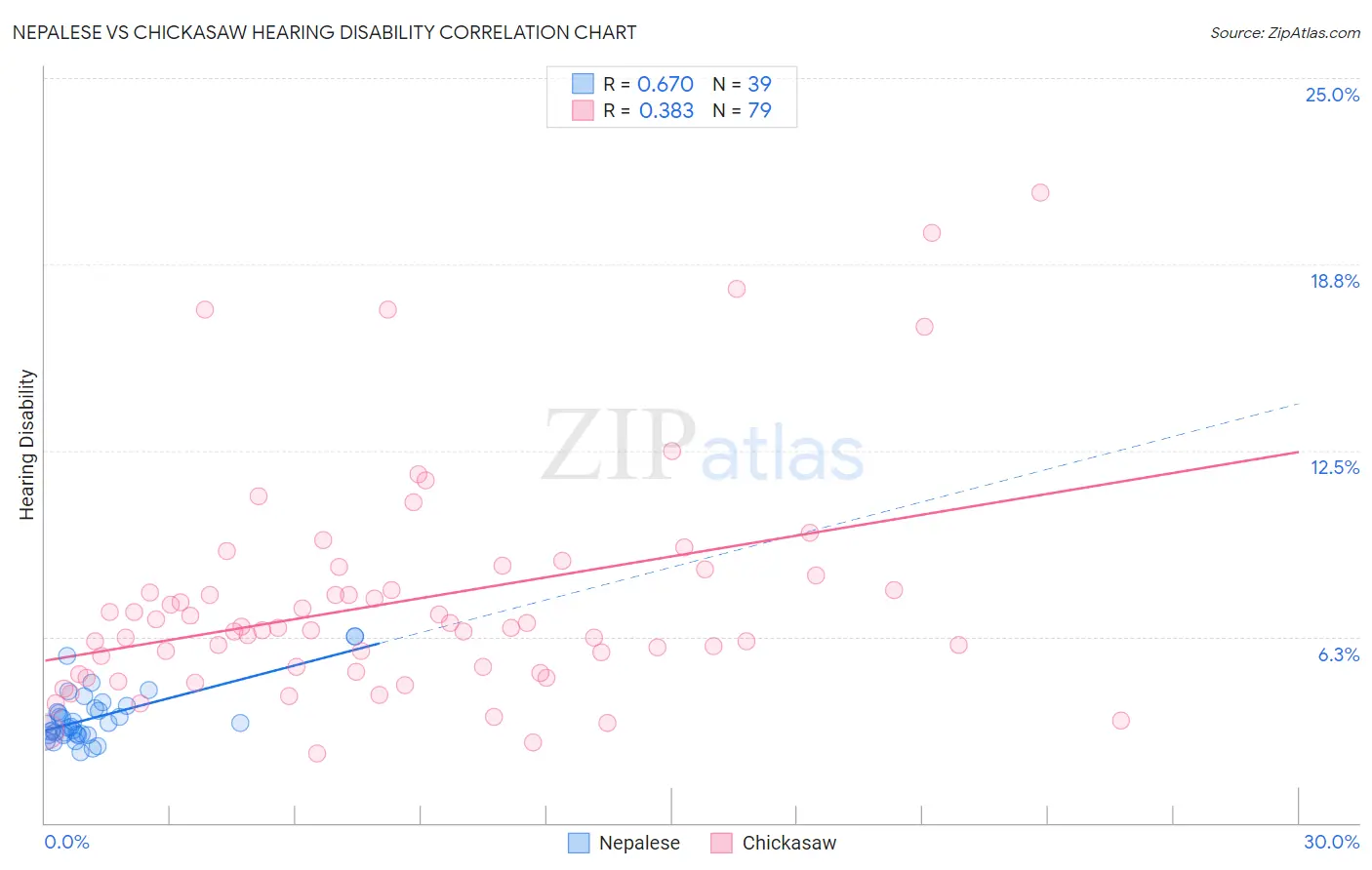Nepalese vs Chickasaw Hearing Disability
COMPARE
Nepalese
Chickasaw
Hearing Disability
Hearing Disability Comparison
Nepalese
Chickasaw
3.3%
HEARING DISABILITY
1.2/ 100
METRIC RATING
239th/ 347
METRIC RANK
4.5%
HEARING DISABILITY
0.0/ 100
METRIC RATING
337th/ 347
METRIC RANK
Nepalese vs Chickasaw Hearing Disability Correlation Chart
The statistical analysis conducted on geographies consisting of 24,517,800 people shows a significant positive correlation between the proportion of Nepalese and percentage of population with hearing disability in the United States with a correlation coefficient (R) of 0.670 and weighted average of 3.3%. Similarly, the statistical analysis conducted on geographies consisting of 147,680,195 people shows a mild positive correlation between the proportion of Chickasaw and percentage of population with hearing disability in the United States with a correlation coefficient (R) of 0.383 and weighted average of 4.5%, a difference of 35.5%.

Hearing Disability Correlation Summary
| Measurement | Nepalese | Chickasaw |
| Minimum | 2.4% | 2.3% |
| Maximum | 6.3% | 21.2% |
| Range | 3.9% | 18.8% |
| Mean | 3.5% | 7.4% |
| Median | 3.3% | 6.5% |
| Interquartile 25% (IQ1) | 3.0% | 5.1% |
| Interquartile 75% (IQ3) | 3.9% | 8.3% |
| Interquartile Range (IQR) | 0.90% | 3.2% |
| Standard Deviation (Sample) | 0.92% | 3.8% |
| Standard Deviation (Population) | 0.91% | 3.8% |
Similar Demographics by Hearing Disability
Demographics Similar to Nepalese by Hearing Disability
In terms of hearing disability, the demographic groups most similar to Nepalese are Immigrants from Netherlands (3.3%, a difference of 0.18%), Samoan (3.3%, a difference of 0.25%), Yugoslavian (3.3%, a difference of 0.36%), Immigrants from Western Europe (3.3%, a difference of 0.53%), and Assyrian/Chaldean/Syriac (3.3%, a difference of 0.60%).
| Demographics | Rating | Rank | Hearing Disability |
| Ukrainians | 2.9 /100 | #232 | Tragic 3.2% |
| Estonians | 2.4 /100 | #233 | Tragic 3.3% |
| Central American Indians | 2.3 /100 | #234 | Tragic 3.3% |
| Guamanians/Chamorros | 2.2 /100 | #235 | Tragic 3.3% |
| Serbians | 2.2 /100 | #236 | Tragic 3.3% |
| Immigrants | Austria | 1.8 /100 | #237 | Tragic 3.3% |
| German Russians | 1.8 /100 | #238 | Tragic 3.3% |
| Nepalese | 1.2 /100 | #239 | Tragic 3.3% |
| Immigrants | Netherlands | 1.1 /100 | #240 | Tragic 3.3% |
| Samoans | 1.1 /100 | #241 | Tragic 3.3% |
| Yugoslavians | 1.0 /100 | #242 | Tragic 3.3% |
| Immigrants | Western Europe | 1.0 /100 | #243 | Tragic 3.3% |
| Assyrians/Chaldeans/Syriacs | 0.9 /100 | #244 | Tragic 3.3% |
| Immigrants | Scotland | 0.8 /100 | #245 | Tragic 3.3% |
| Immigrants | England | 0.7 /100 | #246 | Tragic 3.3% |
Demographics Similar to Chickasaw by Hearing Disability
In terms of hearing disability, the demographic groups most similar to Chickasaw are Alaska Native (4.5%, a difference of 0.21%), Choctaw (4.5%, a difference of 1.6%), Creek (4.4%, a difference of 2.5%), Pueblo (4.6%, a difference of 3.2%), and Kiowa (4.3%, a difference of 3.2%).
| Demographics | Rating | Rank | Hearing Disability |
| Natives/Alaskans | 0.0 /100 | #330 | Tragic 4.2% |
| Cherokee | 0.0 /100 | #331 | Tragic 4.2% |
| Houma | 0.0 /100 | #332 | Tragic 4.2% |
| Dutch West Indians | 0.0 /100 | #333 | Tragic 4.3% |
| Aleuts | 0.0 /100 | #334 | Tragic 4.3% |
| Kiowa | 0.0 /100 | #335 | Tragic 4.3% |
| Creek | 0.0 /100 | #336 | Tragic 4.4% |
| Chickasaw | 0.0 /100 | #337 | Tragic 4.5% |
| Alaska Natives | 0.0 /100 | #338 | Tragic 4.5% |
| Choctaw | 0.0 /100 | #339 | Tragic 4.5% |
| Pueblo | 0.0 /100 | #340 | Tragic 4.6% |
| Navajo | 0.0 /100 | #341 | Tragic 4.6% |
| Tsimshian | 0.0 /100 | #342 | Tragic 4.7% |
| Inupiat | 0.0 /100 | #343 | Tragic 4.7% |
| Tlingit-Haida | 0.0 /100 | #344 | Tragic 4.8% |